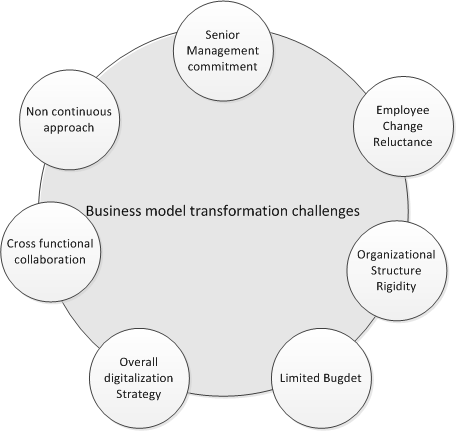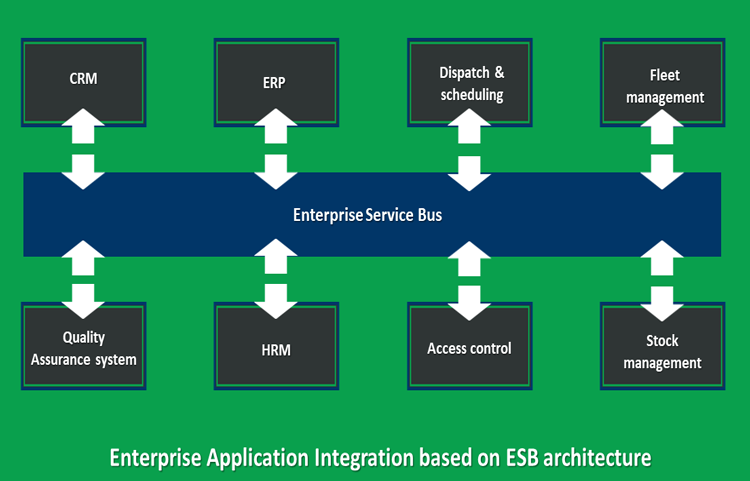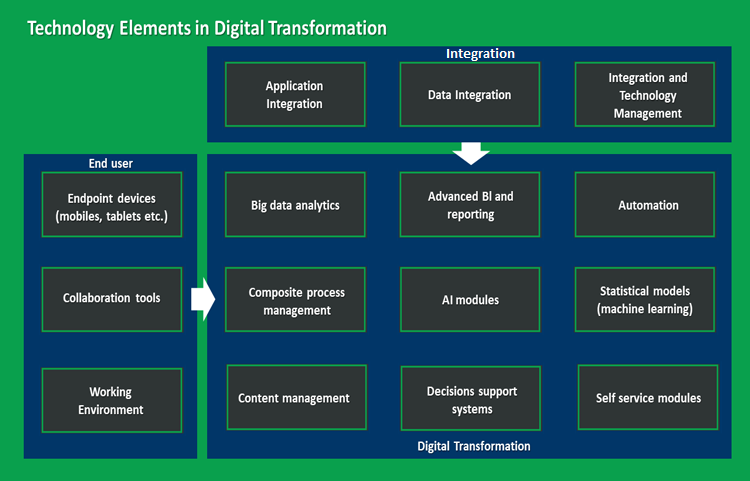Build a Digital Transformation Roadmap on Salesforce.com
Recognized as a world-leading technology platform for driving sales growth, Salesforce.com evolved from an enterprise CRM application to an interconnected network of cloud modules able to concentrate and manage customer data, operations, and several business processes in a powerful, unified environment.People adopt new digital technologies to their ever-changing needs and habits, reshaping markets along with them. To stay agile and effective, companies must digitally transform to utilize the technologies as well.
However, you may face limitations and challenges if you focus your deployment on a large and complex Salesforce deployment without upfront planning. While you start out with easy quick ‘wins’, your ‘wins’ become neither easy nor quick as your implementation and adaptation grows, resulting in a more rigid and inflexible environment.
Still, digitally transforming your operations to Salesforce Saudi Arabia can help you reduce your risks and face these challenges, provided you properly optimize it.
Elements of a Digital Transformation Roadmap
Digital transformation building blocks
A digital transformation realised through Salesforce helps achieve better performance on both your internal and external customer related processes. Primarily, it is for your sales and marketing efforts followed by your operations. It helps continuous improvements around business models and internal processes by providing the necessary technology resources.

Business Model Transformation
Digital transformation does not change how your company uses technology. It just changes how you effectively do business through the use of technology. According to studies of manufacturing companies, the lack of technology expertise or technology tools are very rarely the primary obstacles in a digital transformation.

Management commitment
More than any other component of success, senior management commitment to digital transformation is a key factor as the use of Salesforce requires more agility and effectiveness than traditional methods:
- A new digital business may introduce a number of digital components into it’s ‘stack’. For instance, a product line of digital products, digital distribution channels for promotion and delivery, software based supply chain and sales platforms, and new ways of communicating with customers using the internet. All these require organizational structural changes, employee motivation and training, or entirely new business rules and processes. Humans are always reluctant to change, and require compelling reasons to change the way in which they work.
- Although budget constraints may limit the overall journey, it can still align with your strategy. Digital transformation is a continuous journey that requires distributing your financial resources over different periods.
Overall digitalization strategy
Salesforce digital transformation Saudi Arabia is not a one-time project. It is a continuous “journey”. While it may start with small, quick accomplishments, it quickly requires adjusting your entire company according to the technology evolution. Because of this, you should perform it in a consistent manner, governed by an overall strategic plan.
Collaboration — Continuous Improvements
Salesforce.com provides strong collaboration tools that create transparency throughout your business processes. Furthermore, your employees may work from anywhere, with any device, at any time. The digital transformation journey continuously adjusts your business in an easy way using effective workflow modelling tools.
Improving cross-functional collaboration of your staff with the use of technology, such as drag-and-drop editors, point-and-click report and dashboard builders, and simple but effective automation can be easily achieved using Salesforce as the core of your digital transformation project.
Using the Right Technology in the Right Way
Since Salesforce provides core digital transformation tools, having the available technology is not the primary challenge. Instead, the major challenges are selecting and using the right technology architecture.

Application and Data Integration

Integration is the key to a successful digital transformation. Legacy applications may run on different platforms with different technologies and data formats. Integration can turn them into a composite application that can reference the superset of data.
For example, in an integrated environment, Salesforce serves as the ‘master’ application, containing and governing the superset of data and services. Because of this, it should be aware of all customer related information, regardless of the source, providing all the tools required to virtualize and manage the data. This may require an initial data migration with subsequent update flows.
Integration should be a significant part in your overall architecture design. Consider a new legacy on premise application that should be incorporated. How will this be achieved? By custom development? By searching Salesforce AppExchange for a substitute module and then migrating? Or by integration?
While the first two options are all-in-one place approaches, integration may have more benefits overall.
Is Salesforce the best fit for my business?
Not all companies require the same elements in a digital transformation project. Additionally, not all companies start from the same point and have the same financial resources. Prioritizing while taking into account your financial constraints and technology maturity is a challenge. Fortunately, Salesforce offers several easily-incorporated modules .
Change Management — Develop Internal Resources
Managing and deploying solutions from Appexchange and/or coding a custom solution on Salesforce is a major challenge. As new digital demands arise, both Appexchange and custom development provide quick and effective solutions, but an over-customized solution with several modules may create management issues and cause increased support costs.
In general, when a new demand arises:
- Use 3rd party applications. They provide the functions to do the job. Don’t try to replace them through Appexchange or custom development.
- You should consider implementing integration flows within your transitional and real-time customer-processing services.
- Adopting a good Appexchange solution is better than custom development. You should only choose custom development when no existing module would work in your situation.
- Use integration partners, but own the business process aligned with your architecture.
Sales, Marketing and Operational Performance
Sales and marketing functions always pioneer in the adoption of new technologies, because more than 70% of customers pressure companies to adopt to the new technologies. Currently, technology realities help your marketing and sales teams improve their customer experience.

Since Salesforce.com focuses on sales and marketing processes, one might think that it has nothing to do with your operations. This is not the case for many industries as the following table describes:

Digital technology elements

Application and data Integration
For integrating with 3rd-party systems and applications, Salesforce currently offers an industry standard SOAP/REST Web service API that enables integration with most middleware supporting an enterprise service bus (ESB) architecture. Additionally, cloud-based middleware solutions can govern and manage these application and data integration layers by providing providing a low-code development environment, along with performance monitoring, and an easy way of making adjustments.
Whatever the method used, Cetrix Cloud Services offer professional services in Salesforce integration projects.
Content Management
Hubspot and Salesforce provide ease of development and implementation solutions, along with cross-channel functionalities and other content management capabilities.
Composite Application Management
Agilepoint integrated with Salesforce provides frameworks for monitoring, managing, and evaluating processes based on their interfaces and running systems, along with end user intervention such as approvals.
Big Data Analytics, Advanced BI Reporting
Analytics can help adequately interpret user intent and subsequently pass the results to marketing tools. Analytics modules require consolidated and clean master data. Advanced decision supporting systems, such as lead scoring and dashboards, provide high picture information with key performance indicator (KPI) figures.
AI and Machine Learning Modules
Artificial intelligence systems, such as chatbots, may provide enhanced and fast 1st level support to end users, or may accelerate the production process by automating tasks. Machine learning modules exploit big data innovations to apply statistical models to a set of data. Advanced marketing techniques, such as predictive lead scoring and account-based marketing, then use these models are their sources. Salesforce.com Einstein provides an environment for modeling and implementing such scenarios.
With Salesforce predictive features you can find out who your prospects are. While there is effort required to begin collecting data on your prospects it is worth it.
Salesforce predictive analytics will then allow you to score your leads based on the metrics that you are tracking. As a result, you’re then in a position to quickly, easily and continuously identify the best leads. As you learn about your prospects, you should be ready to spend time thinking through your methods and revisiting and tweaking them.
By progressively profiling your leads using Salesforce predictive analytics, you can automatically collect new information about them every time they interact with you in a digital space. This information enables you to segment your lists and send targeted email campaigns.
A 360 degree view of your prospects and customers can be achieved by creating an integrated MarTech solution within the Salesforce CRM, enabling the software to track the behavior of leads displaying interest by recording click-through of links and conversion events of your online marketing as well as human-to-human contact like on-site visits and phone calls. A Salesforce Predictive MarTech Alignment solution captures and syncs this information automatically.
While lead nurturing using predictive analytics can be challenging to get right, it’s often highly effective when performed well. Effort and resources spent developing and optimizing automated campaigns to help move clients through the buying cycle can pay off. By using Salesforce predictive analytics, you have access to a powerful combination of tools and strategies at your fingertips, while simultaneously ensuring your analytics and data-capture processes are performing correctly.
Einstein out-of-the-box applications (Sales cloud Einstein, Service cloud Einstein and Marketing cloud Einstein) infuse artificial intelligence (AI) into Salesforce, while the Einstein platform provides tools for configuring and customizing the environment. Given its horizontal, multi-tier architecture, AI can be used throughout all Salesforce applications, thereby supporting the entire customer journey.
When it comes to pipeline optimization, Einstein’s predictive analysis is a powerful tool. It is data centric and uses statistical models (machine learning) to find data patterns and make predictions or recommendations about future actions. The results are reliable, accurate and, most importantly, fast. Using the Einstein Prediction Builder, rules and outcomes can be defined while Einstein Analytics and Discovery provide deeper insight into data patterns and study and predict future market scenarios.
Predictive analysis techniques can be used in several stages of the customer journey — from lead or engagement scoring and customer intent analysis to smart analytics and personalized marketing — resulting in pipeline optimization, both quantitatively and qualitatively.
Companies can use predictable prospecting paired with B2B user intent data to maximize the effectiveness of and return on their sales and marketing efforts.
Conclusion
Today, most companies acknowledge that they must digitally transform to survive, and that they should initiate a relevant project in the short term. Companies also need application and data integration, advanced analytics, and artificial intelligence, along with strongly committed management, to achieve the optimum ROI and to ensure the success of their digital transformation project. Cetrix cloud services is a proven, effective, and reliable solution service provider for enhancing customer experience and boosting sales & marketing performance using Salesforce.com. Strong partnerships with digital transformation industry leaders, along with cloud orientation and effective project management, provides the necessary guarantees for successful project completion. Connect with us to discuss your needs and how we can help.








Comments
Post a Comment